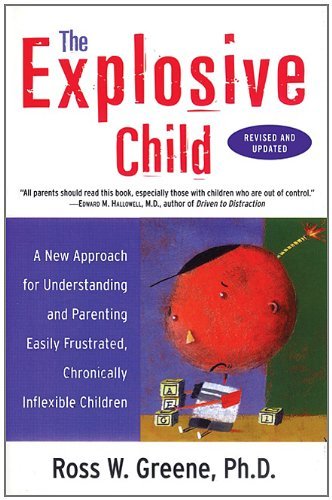Got Explosive Kids?
In the book “The Explosive Child” by Ross W. Greene, Dr. Greene examines how parents can provide feedback to children who exhibit demanding and exhausting behaviors, particularly children with limited frustration understanding and volatile outbreaks.
The book discusses how to understand and approach parenting to easily frustrated, troubling, unrelenting and inflexible children.
The author frequently refers to t he mannerisms of flexibility and frustration tolerance and how parents can assist their children to enhance flexibility and achieve better responses to frustration.
He uses easy language in his recommendations to parents of children enduring many types of behavioral and emotional difficulties such as: Obsessive Compulsive Disorder, Bipolar Disorder, Attention Deficit Hyperactivity Disorder, and Oppositional Defiant Disorder.
Dr. Greene establishes the point that volatile children do not intend to be unyielding and undisciplined. He emphasizes that explosive children are behind other kids their age in establishing mannerisms like adaptability and obedience. These developmental unlikeness can be very disheartening for parents. Parents may, in turn, use allegations and criticism.
According to Dr. Greene, a parent can assist an eruptive child just by acknowledging he does not have the essential comprehension to describe why he functions the ways that he does. When a parent truly realizes this conception, it can make it easier for them to observe the child’s angry eruption as an unfavorable effort of self-expression.
Therapist and counselors, to distract frustration and resentment the parents have built up toward their children’s troublesome behaviors, often use this technique. When parents accept this perspective of their children’s behavior, they are spared of their distress to feel maddened, humiliated or upset about the disruptive behaviors.
Dr. Greene emphasizes that the parents main objective must be shown in their response to a child’s fit of temper outburst. According to Dr. Greene, the episode will diminish if the parent’s intention is to be available, fair minded, receptive, and forth coming without displaying detrimental and critical feelings toward the child.
If the parent’s intention is to “show them who’s boss“, then the author states the child will possibly erupt into a full blown outburst. The author’s method of expressing these recommendations is using unquestionable, brief, directorial, and straightforward examples.
Once parents acknowledge a child is not intentionally misbehaving, the next thing to do is to evaluate the punishments they have given for the child’s previous tantrums. This step is significant because parents need to assess the success of the consequences and discipline methods they have used in the past. This will guide the parents to understand that the meltdowns do not indicate the child’s level of submission.
The goal of parents refereeing with explosive children is not to pressure them to do what the parents want, but rather to work with the children to engage in problem solving.
The author’s opinion is that uncompromising easily discouraged kids need parents to be kind, obliging, sympathetic, caring and considerate rather than authoritarian or a taskmaster. Such children must have adults in harmony with support who understands and can encourage them in altering the conduct of their behaviors.
Dr. Greene stresses parents need to be willing to aid their children with guidance and to lend a helping hand to them instead of getting discouraged, annoyed and irritated with them.
Dr. Greene’s view is that behavioral methods used with most children probably won’t be all that practical with easily irritated or tempestuous, short-tempered children. He theorizes that it is advantageous for parents to closely perceive early on in the tantrum, the child’s behavioral and emotional warning signs. Is the child furious? Is the child discouraged that they can’t do a task like the other children? Using this approach permits parents to recognize if a child is moving toward an outburst and then, if possible, smooth it over.
The “Vapor Lock Stage” (a potential meltdown is a phrase Dr. Greene applies to address the child’s first defiance or opposition to be compliant. As the “Vapor Lock Stage” develops the child comes to a crossroads, a situation where alternatives can be considered.
A crossroads is Dr. Greene’s phrase for the second level of the approaching catastrophe. As stated in “The Explosive Child” Dr. Greene believes the child’s behavior upon reaching the crossroads is usually from the parent’s feedback.
Helping the child by communicating with a warm, compassionate and gentle nature and assisting in problem-solving will most often prohibit the episode from increasing to Level 3 (a meltdown).
Furthermore, a parent’s strict and disciplined tone will in all probability result to Level 3 (a melt down). Dr. Greene is clearly explicit in his definitions of the levels and steps in order to offer support to parents who are very anxious while trying to make an effort to manage a child’s outburst and frustration.
Dr. Greene points out parents must be perceptive. Additionally, they must observe the cautionary indications that a child is beginning to get upset so something can be tactfully reached to calm the child before a build up occurs. Mental health therapist also propose that parents “observe the process of what is going on” in the home, instead of responding to “surface issues”
Dr. Greene stresses that parents must be ready to recognize when he/she is acting with inappropriate conduct moods of toughness, harshness, criticalness or inflexibility to their children. This is frequently the case when children consistently misbehave.
The author believes children imitate their parent’s manner of conduct or the adults closest to them. Much of their antagonistic behaviors can be interpreted simply by studying how parents are associating with their child.
Therefore, what do you do with an explosive child? There are three plans defined in the book that parents can choose. Plan A, Plan B, and Plan C.
Plan A is a strict “my way or the highway” concept. Plan C is a very compliant or laid-back “whatever you want, I give up” technique.
Plan B suggests settling disagreements together with agreeable helpful answers.
It takes into consideration interpreting for them the clear-cut conduct and skillfulness and abilities they haven’t acquired. You explain to them how to work out grievances without outburst and how to see alternatives in their rigid thinking. Rigid thinking is often caused by a rushed judgment, sometimes because the person is disagreeable for some reason, sometimes just because “things have always been that way and they like it, so why change?”
You also have to accept that it is a disability and that you cannot take it as failing or something that is your fault and be upset about it. They are emotionally unable to control frustration. With these children there is nothing intentional about their conduct.
They know what you count upon from them and they know when they are well behaved or out of line. However, when they get discouraged they don’t have the ability to remain composed or understand logically, they just cave in.
They realize what you count upon from them and they would be grateful to have the award and stay clear of the discipline but they are continually unable to measure up to your expectation when they don’t have the ability to handle adversity.
In conclusion, Greene believes in encouraging the child, not penalizing them for something they can’t manage.
He believes…












